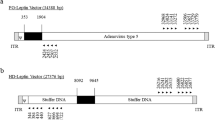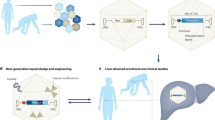Abstract
Delivery of recombinant adeno-associated virus (rAAV) vectors to the newborn liver is followed by a rapid loss of episomal vector copies because of hepatocyte proliferation. In selected hepatocytes, integration of rAAV genomes can lead to a sustained expression of the transgene. The safety of in vivo gene therapy with single-stranded AAV vectors has been questioned in a study reporting a high incidence of hepatocellular carcinoma, associated with provirus integration events in mice that receive an single-stranded AAV injection at birth. To investigate the tumour-initiating potential of the newly established self-complementary AAV (scAAV) vectors in the liver, groups of newborn rats received intravenous injection of a scAAV vector encoding the green fluorescent protein (GFP), or were injected with phosphate-buffered saline (PBS) or diethylnitrosamine (DEN), a well-known liver tumour initiator. The rats were fed on a diet containing 2-acetylaminofluorene, a potent liver tumour-promoting agent to accelerate the carcinogenic process. After 2 months, the animals were killed and their livers analysed. Preneoplastic nodules were identified by glutathion S-transferase-p (GSTp) staining, and GFP expression was detected by immunohistochemistry. Vector genome integration events were analysed. The numbers of GSTp-positive foci were comparable in the PBS and the scAAV–GFP groups and significantly higher in the DEN group. The proportion of GSTp-positive foci that also expressed GFP was low and in the range expected for random occurrence. No specific integration hot spots were detected by linear amplification-mediated-PCR in transduced liver. In conclusion, scAAV transduction of newborn rat liver does not trigger preneoplastic lesions suggesting an absence of liver tumourigenesis.
This is a preview of subscription content, access via your institution
Access options
Subscribe to this journal
Receive 12 print issues and online access
$259.00 per year
only $21.58 per issue
Buy this article
- Purchase on Springer Link
- Instant access to full article PDF
Prices may be subject to local taxes which are calculated during checkout





Similar content being viewed by others
References
Miao CH, Snyder RO, Schowalter DB, Patijn GA, Donahue B, Winther B et al. The kinetics of rAAV integration in the liver. Nat Genet 1998; 19: 13–15.
Rivadeneira ED, Popescu NC, Zimonjic DB, Cheng GS, Nelson PJ, Ross MD et al. Sites of recombinant adeno-associated virus integration. Int J Oncol 1998; 12: 805–810.
Nakai H, Iwaki Y, Kay MA, Couto LB . Isolation of recombinant adeno-associated virus vector-cellular DNA junctions from mouse liver. J Virol 1999; 73: 5438–5447.
Miller DG, Rutledge EA, Russell DW . Chromosomal effects of adeno-associated virus vector integration. Nat Genet 2002; 30: 147–148.
Bell P, Wang L, Lebherz C, Flieder DB, Bove MS, Wu D et al. No evidence for tumorigenesis of AAV vectors in a large-scale study in mice. Mol Ther 2005; 12: 299–306.
Bell P, Moscioni AD, McCarter RJ, Wu D, Gao G, Hoang A et al. Analysis of tumors arising in male B6C3F1 mice with and without AAV vector delivery to liver. Mol Ther 2006; 14: 34–44.
Donsante A, Vogler C, Muzyczka N, Crawford JM, Barker J, Flotte T et al. Observed incidence of tumorigenesis in long-term rodent studies of rAAV vectors. Gene Therapy 2001; 8: 1343–1346.
Donsante A, Miller DG, Li Y, Vogler C, Brunt EM, Russell DW et al. AAV vector integration sites in mouse hepatocellular carcinoma. Science 2007; 317: 477.
Flageul M, Aubert D, Pichard V, Nguyen TH, Nowrouzi A, Schmidt M et al. Transient expression of genes delivered to newborn rat liver using recombinant adeno-associated virus 2/8 vectors. J Gene Med 2009; 11: 689–696.
Satoh K, Kitahara A, Soma Y, Inaba Y, Hatayama I, Sato K . Purification, induction, and distribution of placental glutathione transferase: a new marker enzyme for preneoplastic cells in the rat chemical hepatocarcinogenesis. Proc Natl Acad Sci USA 1985; 82: 3964–3968.
Solt D, Farber E . New principle for the analysis of chemical carcinogenesis. Nature 1976; 263: 701–703.
Wang L, Wang H, Bell P, McMenamin D, Wilson JM . Hepatic gene transfer in neonatal mice by adeno-associated virus serotype 8 vector. Hum Gene Ther 2012; 23: 533–539.
Pogribny IP, Muskhelishvili L, Tryndyak VP, Beland FA . The tumor-promoting activity of 2-acetylaminofluorene is associated with disruption of the p53 signaling pathway and the balance between apoptosis and cell proliferation. Toxicol Appl Pharmacol 2009; 235: 305–311.
Li H, Malani N, Hamilton SR, Schlachterman A, Bussadori G, Edmonson SE et al. Assessing the potential for AAV vector genotoxicity in a murine model. Blood 2011; 117: 3311–3319.
Lee YM, Jun HS, Pan CJ, Lin SR, Wilson LH, Mansfield BC et al. Prevention of hepatocellular adenoma and correction of metabolic abnormalities in murine glycogen storage disease type Ia by gene therapy. Hepatology 2012; 56: 1719–1729.
Nathwani AC, Tuddenham EG, Rangarajan S, Rosales C, McIntosh J, Linch DC et al. Adenovirus-associated virus vector-mediated gene transfer in hemophilia B. N Engl J Med 2011; 365: 2357–2365.
Binny C, McIntosh J, Della Peruta M, Kymalainen H, Tuddenham EG, Buckley SM et al. AAV-mediated gene transfer in the perinatal period results in expression of FVII at levels that protect against fatal spontaneous hemorrhage. Blood 2012; 119: 957–966.
McCarty DM, Fu H, Monahan PE, Toulson CE, Naik P, Samulski RJ . Adeno-associated virus terminal repeat (TR) mutant generates self-complementary vectors to overcome the rate-limiting step to transduction in vivo. Gene Therapy 2003; 10: 2112–2118.
Brown BD, Venneri MA, Zingale A, Sergi Sergi L, Naldini L . Endogenous microRNA regulation suppresses transgene expression in hematopoietic lineages and enables stable gene transfer. Nat Med 2006; 12: 585–591.
Chenuaud P, Larcher T, Rabinowitz JE, Provost N, Joussemet B, Bujard H et al. Optimal design of a single recombinant adeno-associated virus derived from serotypes 1 and 2 to achieve more tightly regulated transgene expression from nonhuman primate muscle. Mol Ther 2004; 9: 410–418.
Cany J, Avril A, Pichard V, Aubert D, Ferry N, Conchon S . A transgenic mouse with beta-Galactosidase as a fetal liver self-antigen for immunotherapy studies. J Hepatol 2007; 47: 396–403.
Schmidt M, Schwarzwaelder K, Bartholomae C, Zaoui K, Ball C, Pilz I et al. High-resolution insertion-site analysis by linear amplification-mediated PCR (LAM-PCR). Nat Methods 2007; 4: 1051–1057.
Gabriel R, Eckenberg R, Paruzynski A, Bartholomae CC, Nowrouzi A, Arens A et al. Comprehensive genomic access to vector integration in clinical gene therapy. Nat Med 2009; 15: 1431–1436.
Cartier N, Hacein-Bey-Abina S, Bartholomae CC, Veres G, Schmidt M, Kutschera I et al. Hematopoietic stem cell gene therapy with a lentiviral vector in X-linked adrenoleukodystrophy. Science 2009; 326: 818–823.
Nowrouzi A, Penaud-Budloo M, Kaeppel C, Appelt U, Le Guiner C, Moullier P et al. Integration frequency and intermolecular recombination of rAAV vectors in non-human primate skeletal muscle and liver. Mol Ther 2012; 20: 1177–1186.
Acknowledgements
This work was supported by the Association Française contre les Myopathies (AFM). V Gauttier was funded by INSERM and la Région Pays de la Loire.
Author information
Authors and Affiliations
Corresponding author
Ethics declarations
Competing interests
The authors declare no conflict of interest.
Rights and permissions
About this article
Cite this article
Gauttier, V., Pichard, V., Aubert, D. et al. No tumour-initiating risk associated with scAAV transduction in newborn rat liver. Gene Ther 20, 779–784 (2013). https://doi.org/10.1038/gt.2013.7
Received:
Accepted:
Published:
Issue Date:
DOI: https://doi.org/10.1038/gt.2013.7



